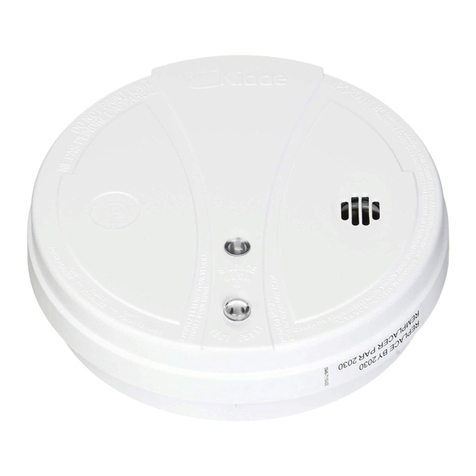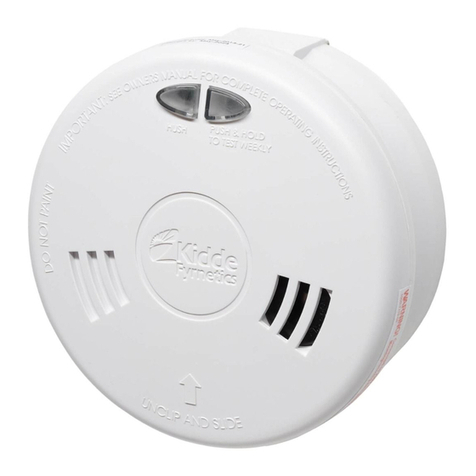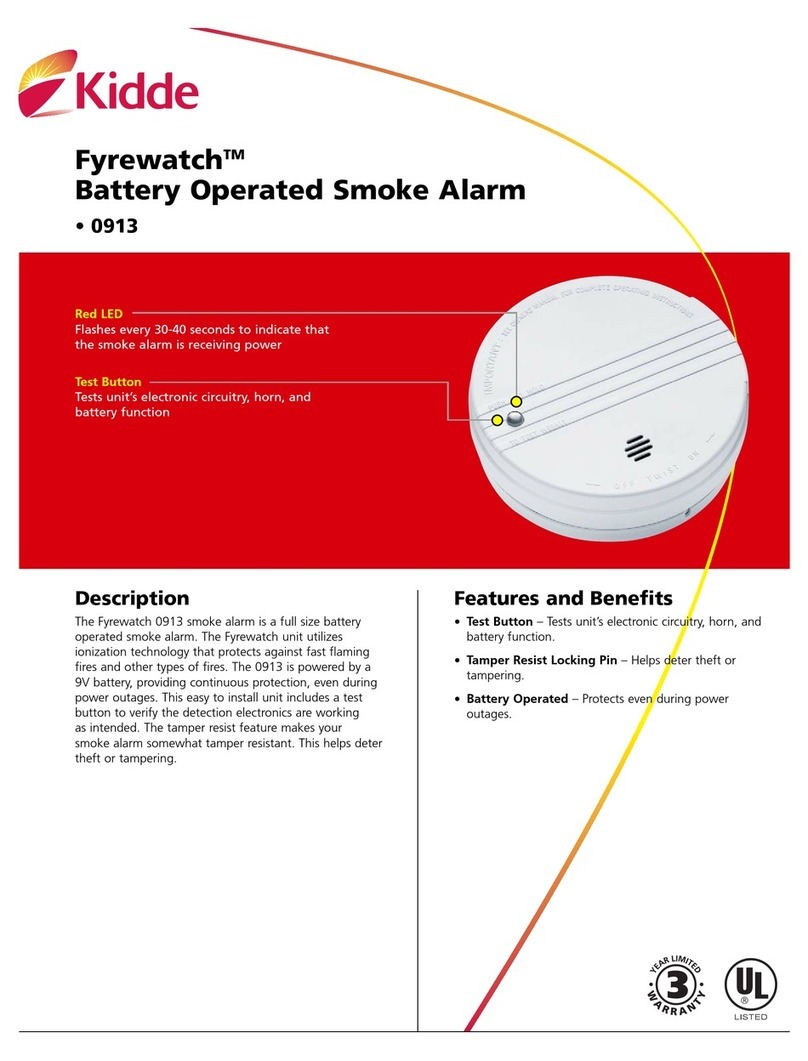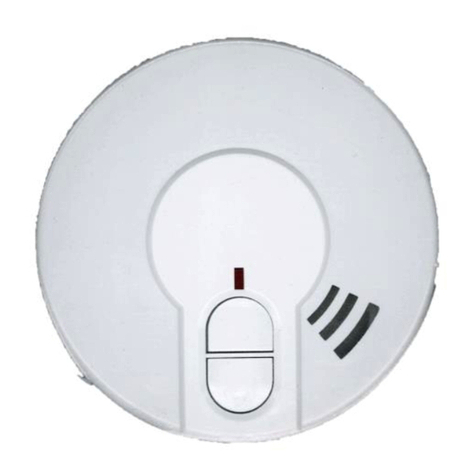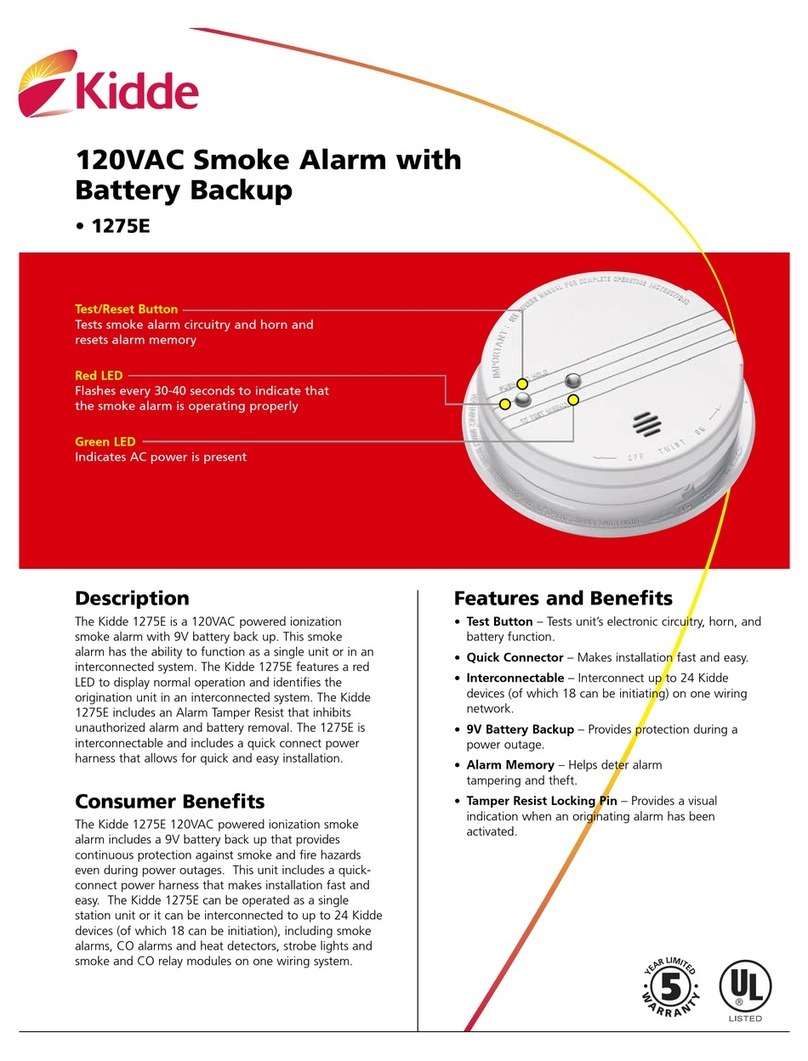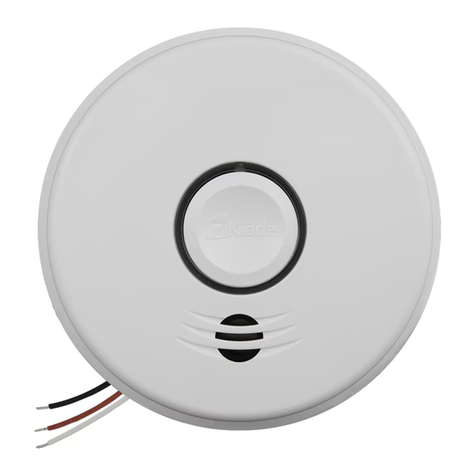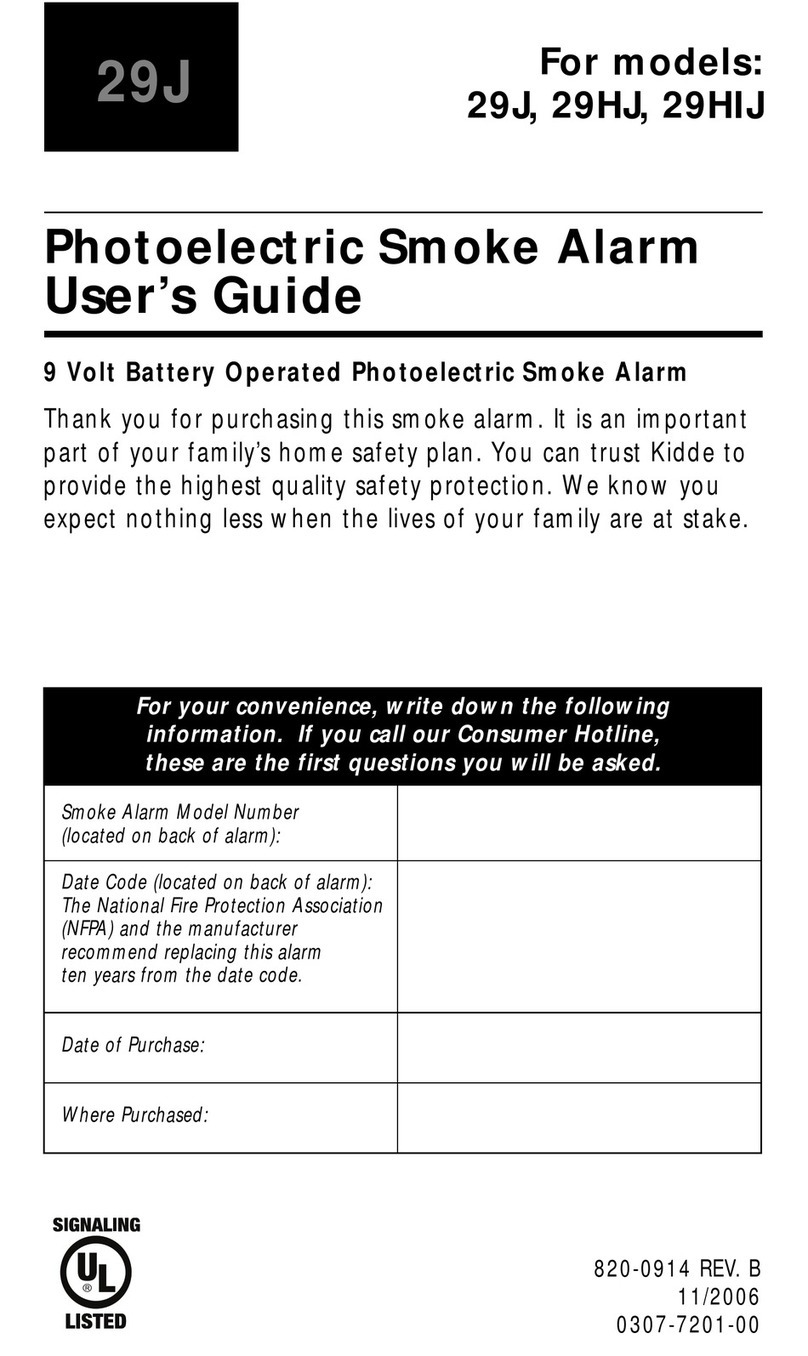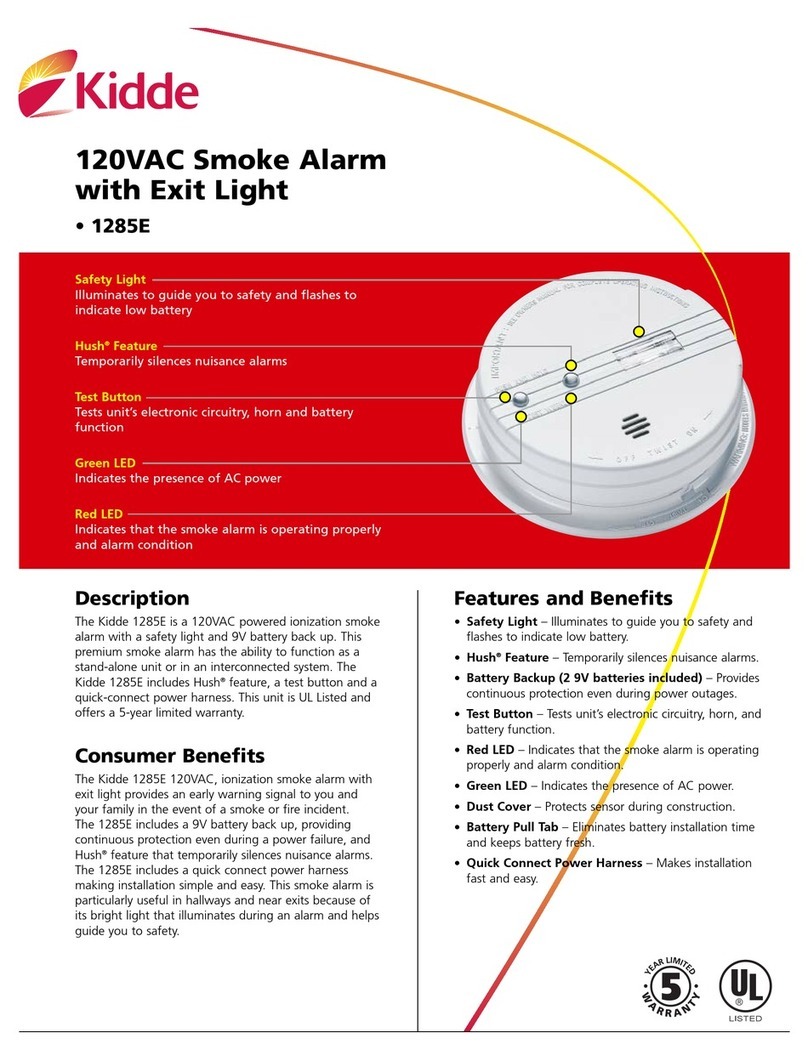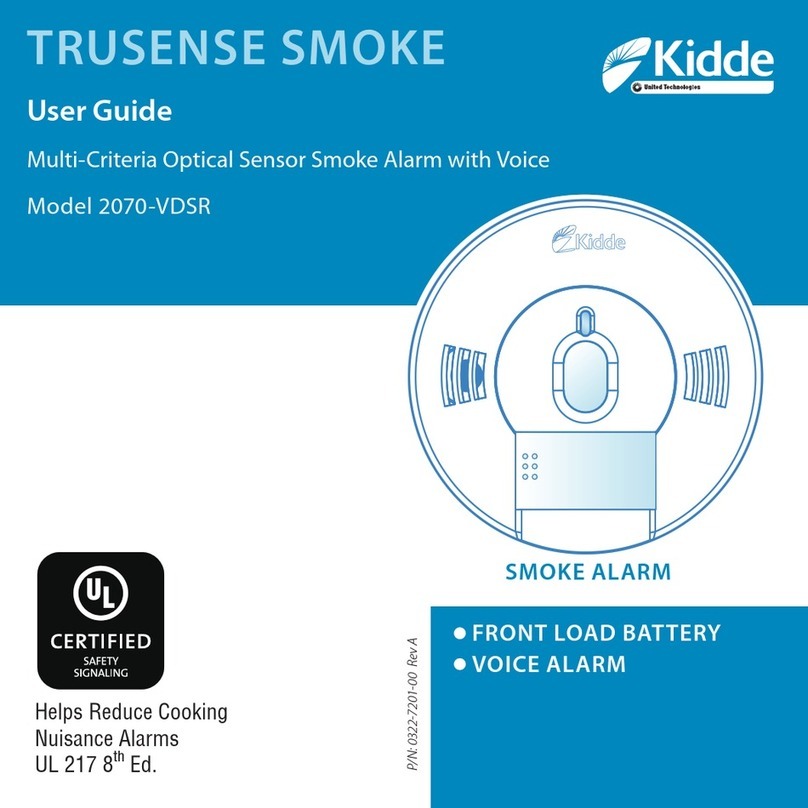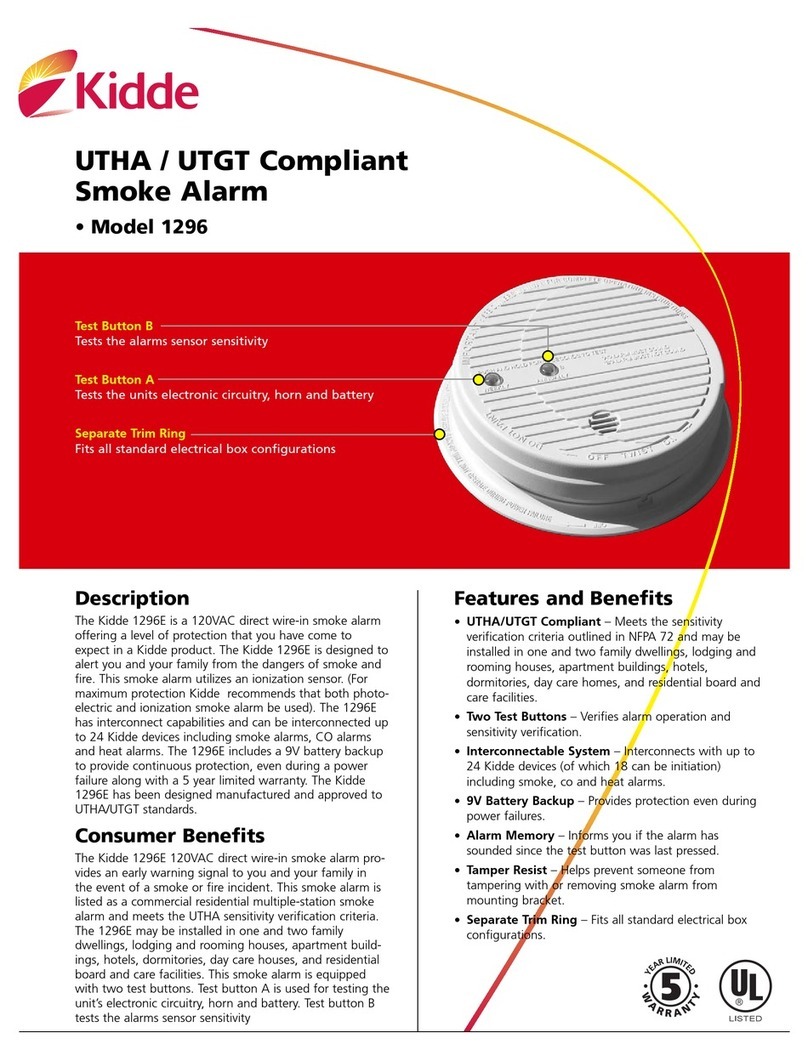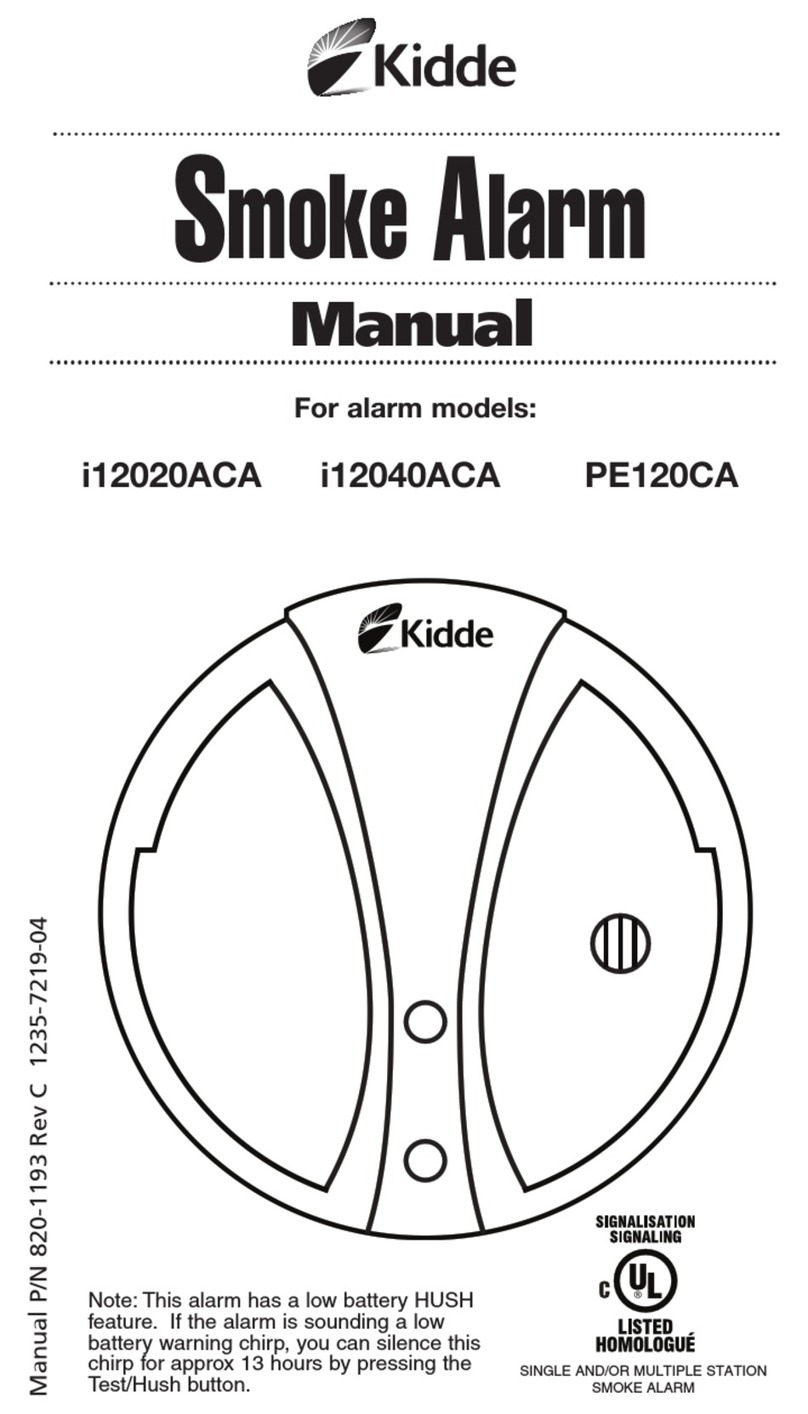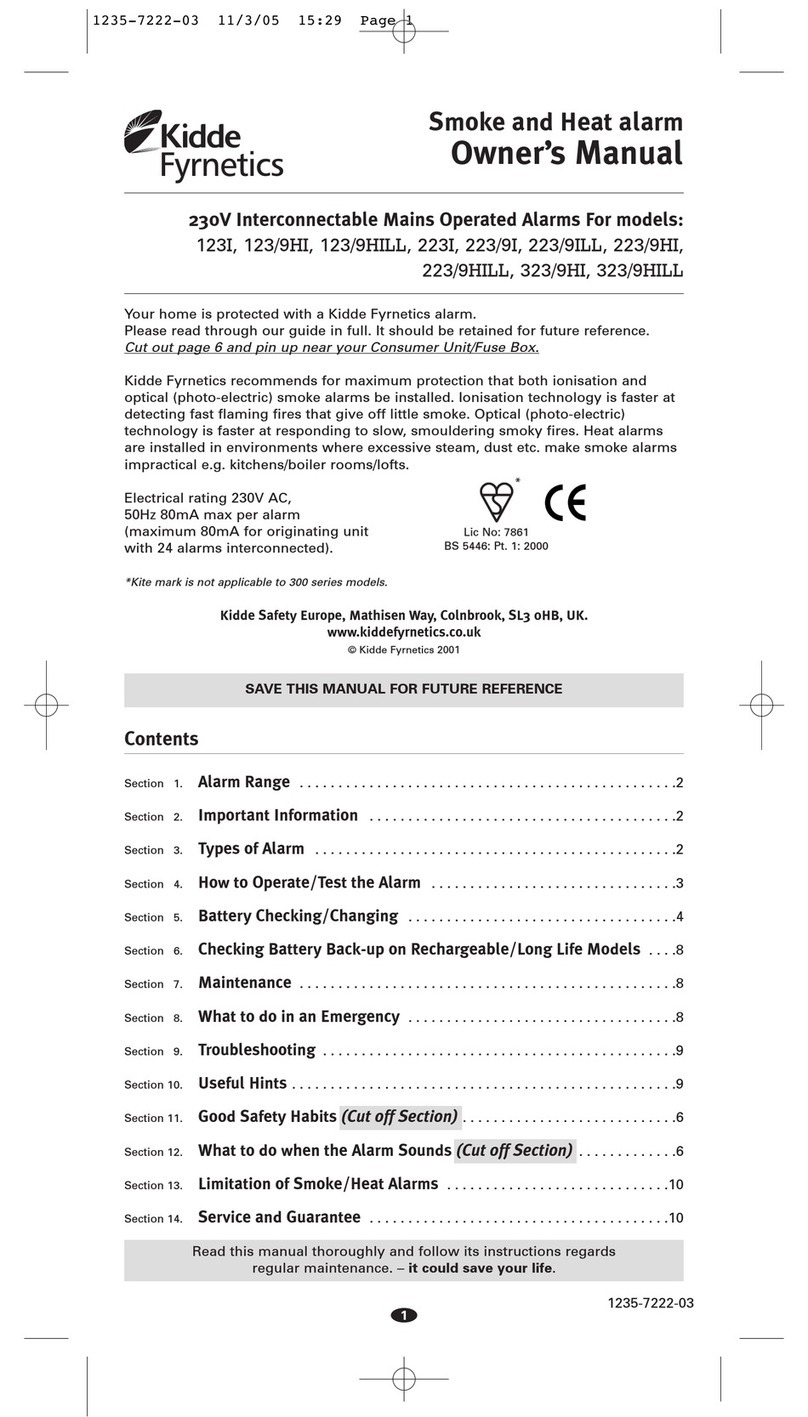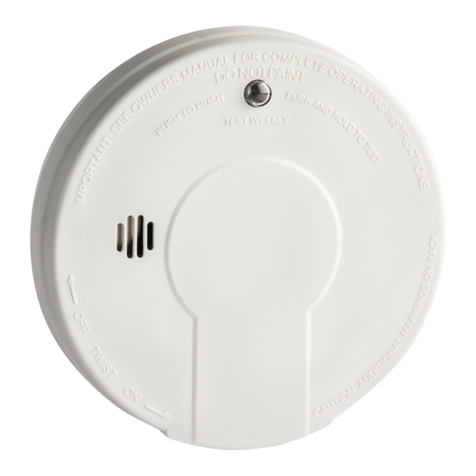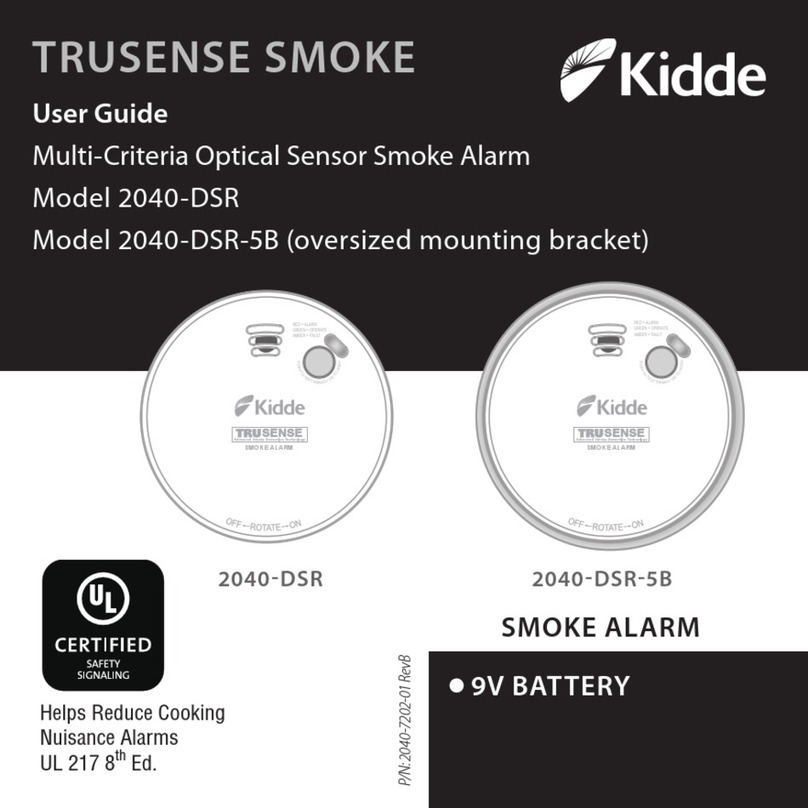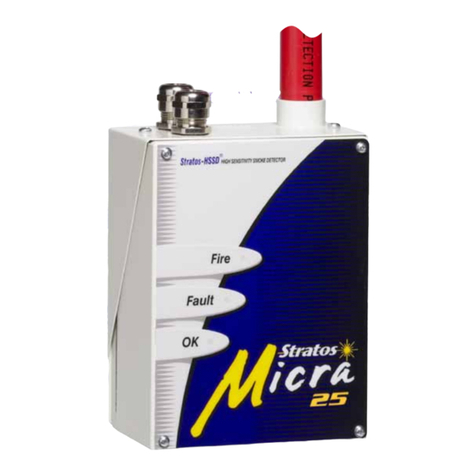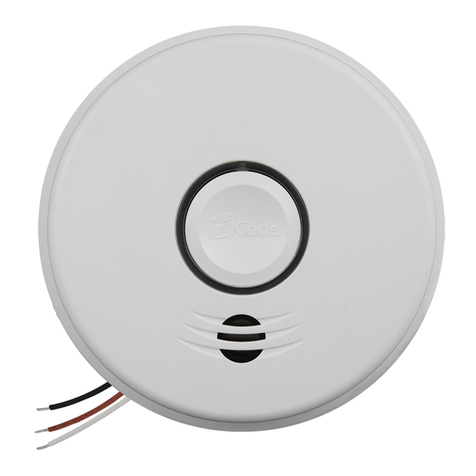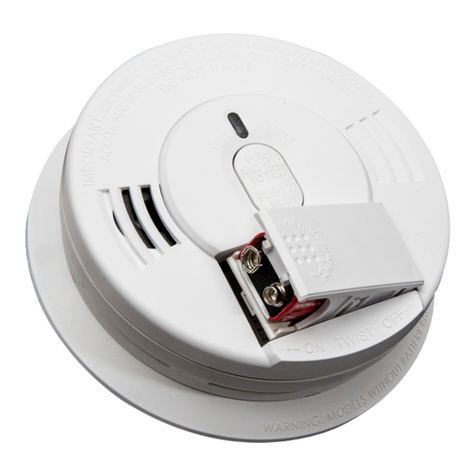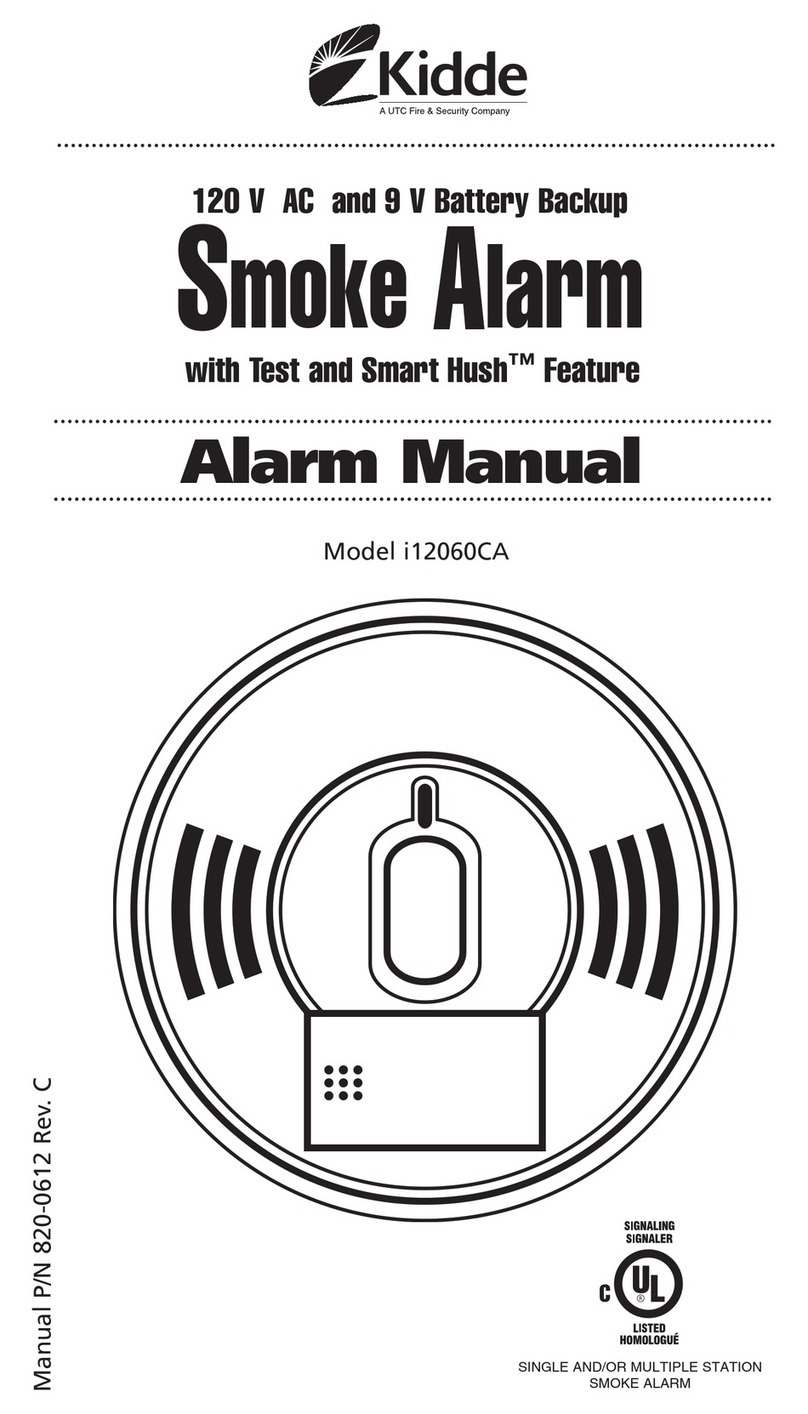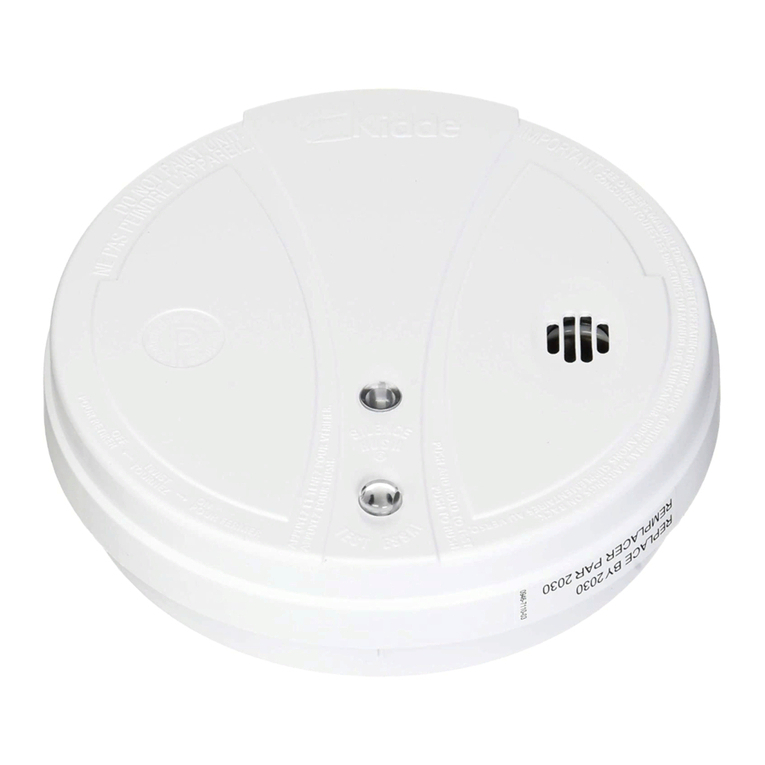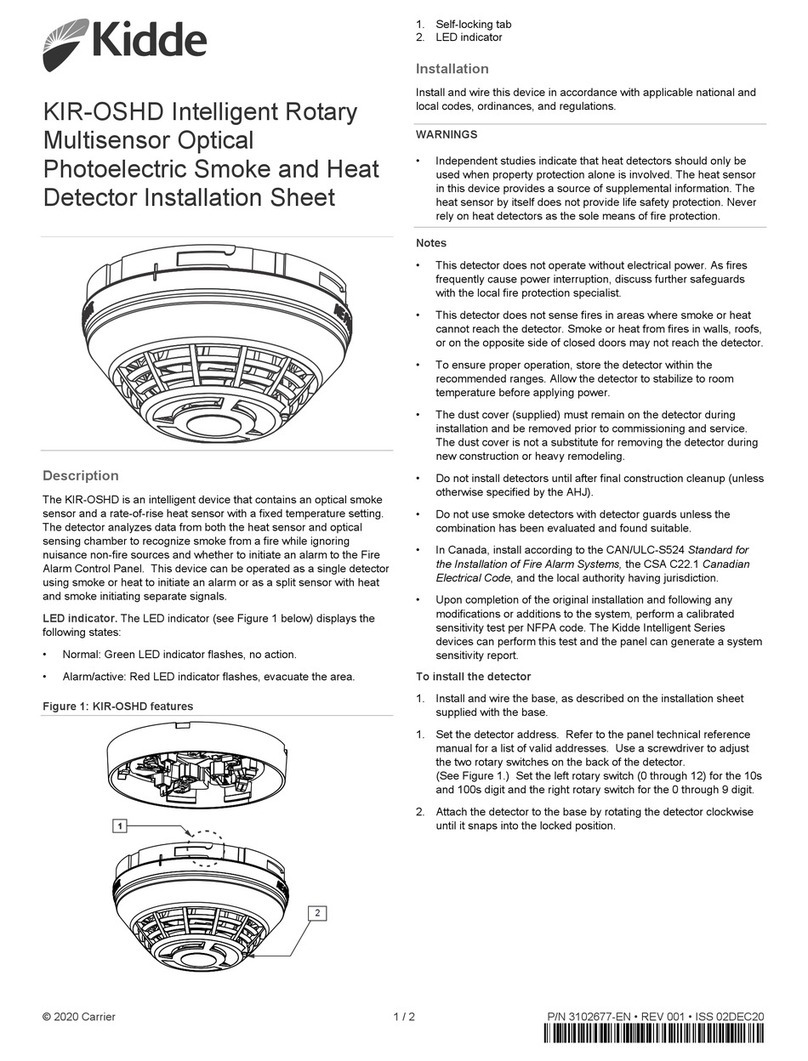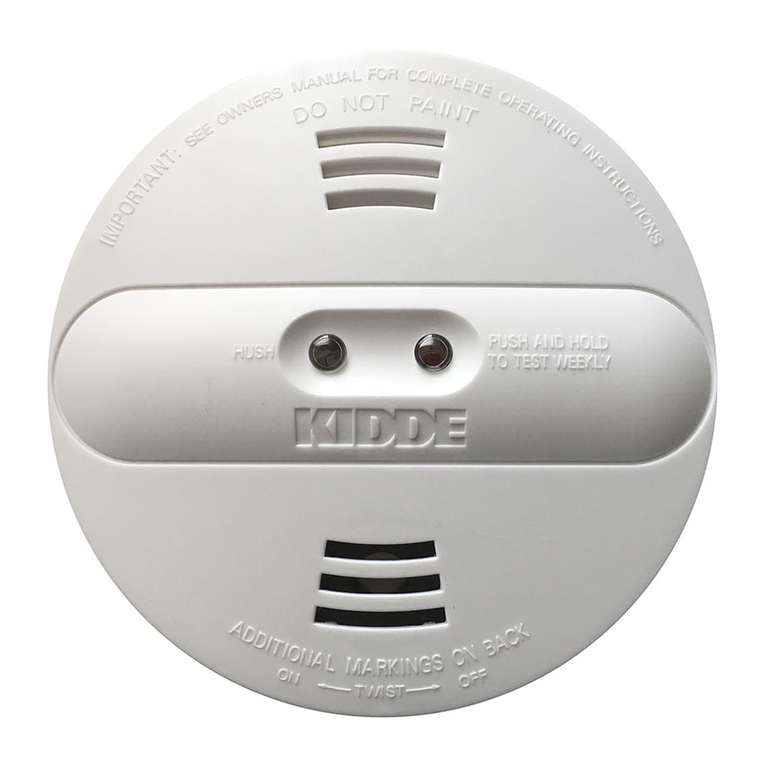6. MAINTENANCE
BATTERY REPLACEMENT
If tamper resist pin has been used, refer to TAMPER RESIST LOCKING PIN in Section 3 for
removal instructions.
To replace the battery, remove the alarm from the mounting plate by rotating the alarm in the
direction of the “OFF” arrow on the cover (see Section 3, Figure 1).
The Model PE9UK Smoke Alarm is powered by a 9V alkaline zinc battery (alkaline and lithium
battery may also be used). A fresh battery should last for one year under normal operating
conditions. This alarm has a low battery monitor circuit which will cause the alarm to “chirp”
approximately every 30-40 seconds for a minimum of seven (7) days when the battery gets low.
Replace the battery when this condition occurs.
USE ONLY THE FOLLOWING 9 VOLT BATTERIES FOR SMOKE ALARM REPLACEMENT:
Alkaline Type: EVEREADY 522, DURACELL MN1604,MX1604
GOLD PEAK 1604A
Lithium Type: ULTRALIFE U9VL
NOTE: REGULAR TESTING IS RECOMMENDED.
WARNING! USE ONLY THE BATTERIES SPECIFIED. USE OF DIFFERENT BATTERIES
MAY HAVE A DETRIMENTAL EFFECT ON THE SMOKE ALARM.
Caution For Lithium only:
Danger of explosion if battery is incorrectly replaced. Replace only with the same or
equivalent type.
CLEANING YOUR ALARM
To clean your alarm, remove it from the mounting bracket as outlined in the beginning of this
section. You can clean the interior of your alarm (sensing chamber) by using your vacuum
cleaner hose and vacuuming through the openings around the perimeter of the alarm. The
outside of the alarm can be wiped with a damp cloth.
After cleaning, reinstall your alarm. Test your alarm by using the test button.
7. LIMITATIONS OF SMOKE ALARMS
WARNING: PLEASE READ CAREFULLY AND THOROUGHLY
Smoke alarms are devices that can provide early warning of possible fires at a reasonable
cost; however, alarms have sensing limitations. Ionisation type alarms offer a broad range of
fire sensing capabilities but are better at detecting fast flaming fires than slow smouldering
fires. Photoelectric alarms sense smouldering fires better than flaming fires. Home fires
develop in different ways and are often unpredictable. Neither type of alarm (photoelectric or
ionisation) is always best, and a given alarm may not always provide warning of a fire.
• A battery powered alarm must have a battery of the specified type, in good condition and
installed properly.
• Mains powered alarms will not operate if the mains power has been cut off, such as by an
electrical fire or an open fuse.
• Smoke alarms must be tested regularly to make sure the batteries and the alarm circuits
are in good operating condition.
• Smoke alarms cannot provide an alarm if smoke does not reach the alarm. Therefore,
smoke alarms may not sense fires starting in chimneys, walls, on roofs, on the other side
of a closed door or on a different floor.
• If the alarm is located outside the bedroom or on a different floor, it may not wake up a
sound sleeper.
• The use of alcohol or drugs may also impair one’s ability to hear the smoke alarm. For
maximum protection, a smoke alarm should be installed in each sleeping area on every
level of a home.
• Although smoke alarms can help save lives by providing an early warning of a fire, they are
not a substitute for an insurance policy. Home owners and tenants should have adequate
5
7. USING TAMPER RESIST LOCKING PIN: To
make your smoke alarm somewhat tamper
resistant, a locking pin has been provided in
the bag with the screws and anchors. Using
this pin will deter children and others from
removing the alarm from the mounting plate.
To use the pin, insert it into the hole in the side
of the alarm after the alarm has been installed
on the mounting plate (see Figure 5).
NOTE: THE TAMPER RESIST PIN WILL HAVE TO BE REMOVED IN ORDER TO CHANGE
THE BATTERY. USE LONG NOSE PLIERS TO PULL THE PIN OUT OF THE HOLE. IT IS
NOW POSSIBLE TO REMOVE THE ALARM FROM THE MOUNTING PLATE.
8. After installation, test your alarm by depressing and holding down the test button for
several seconds, or by blowing smoke into the alarm. This should sound the alarm.
CAUTION! EARLY WARNING FIRE DETECTION IS BEST ACHIEVED BY THE INSTALLATION OF
FIRE DETECTION EQUIPMENT IN ALL ROOMS AND AREAS OF THE HOUSEHOLD AS FOLLOWS:
A SMOKE ALARM INSTALLED IN EACH SEPARATE SLEEPING AREA (IN THE VICINITY OF - BUT
OUTSIDE OF THE BEDROOM) AND HEAT OR SMOKE ALARMS IN THE LIVING ROOM, DINING
ROOM, KITCHEN, HALLWAYS, ATTIC, BOILER ROOM, CLOSETS, UTILITY STORAGE ROOM,
CELLARS AND ATTACHED GARAGE.
4. OPERATION AND TESTING
OPERATION: The smoke alarm is operating once a fresh battery is installed and testing is
complete. When products of combustion are sensed, the unit sounds a loud 85db pulsating
alarm until the air is cleared.
FLASHING LED LIGHT: This smoke alarm is equipped with a flashing red indicator light. The
light is located under the test button and will flash every 30-40 seconds to indicate that the
smoke alarm is receiving power.
SMOKE SENSING CHAMBER OPERATION: This alarm will “chirp” if any of the components in
the smoke sensing chamber fail. This chirp will occur between the flashes of the red LED
indicator light. (If the chirp occurs at the same time as the red LED flash, see Section 6 for low
battery information).
TESTING: Test by pushing the test button on the cover and holding it down for a minimum of
5 seconds. This will sound the alarm if the electronic circuitry, horn and battery are working. If
no alarm sounds, the unit has defective batteries or other failure. You can also test the alarm
by blowing smoke into it.
TEST THE ALARM WEEKLY TO ENSURE PROPER OPERATION. Erratic or low sound coming
from your alarm may indicate a defective alarm and it should be returned for service (see
Section 9).
5. NUISANCE ALARMS
Smoke alarms are designed to minimise nuisance alarms. Cigarette smoke will not normally
set off the alarm, unless the smoke is blown directly into the alarm. Combustion particles from
cooking may set off the alarm if the alarm is located close to the cooking area. Large quantities
of combustible particles are generated from spills or when broiling. Using the fan on a cooker
hood which vents to the outside (non-recirculating type) will also help remove these
combustible products from the kitchen.
If the alarm sounds, check for fires first. If a fire is discovered, get out and call the fire brigade.
If no fire is present, check to see if one of the reasons listed in Section 2 may have caused the
alarm.
4
FIGURE 5
Tamper Resist Locking Pin
